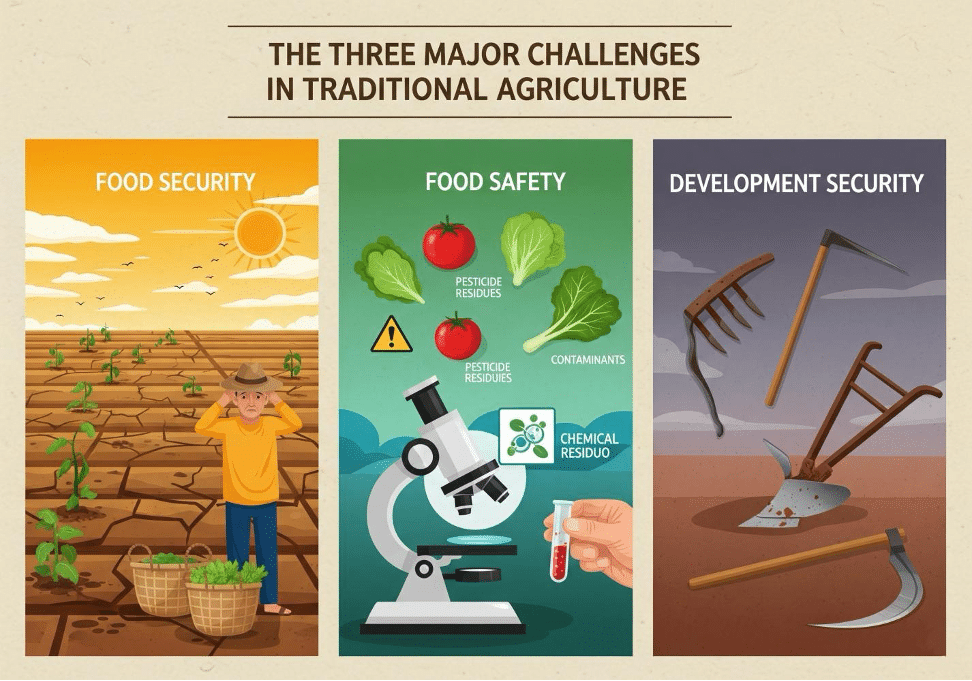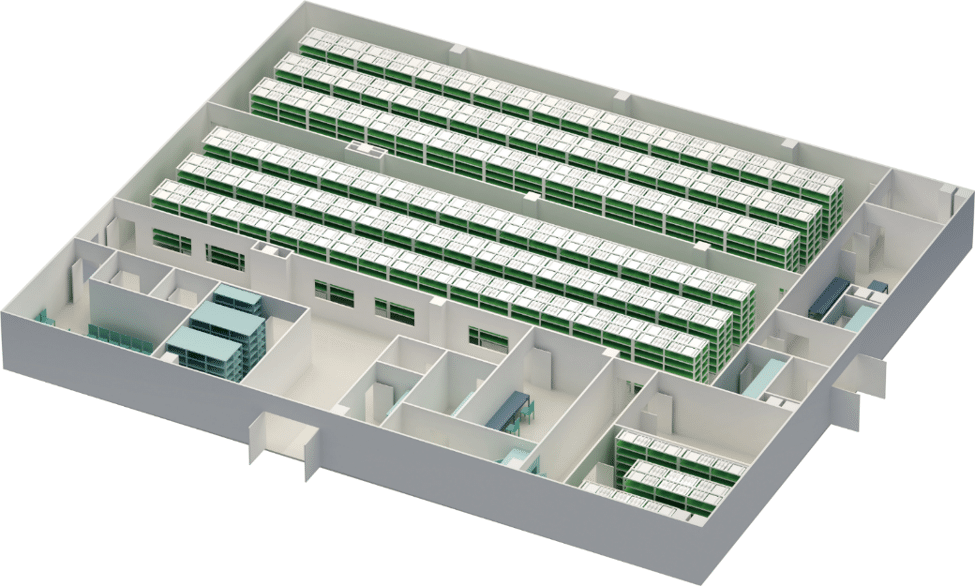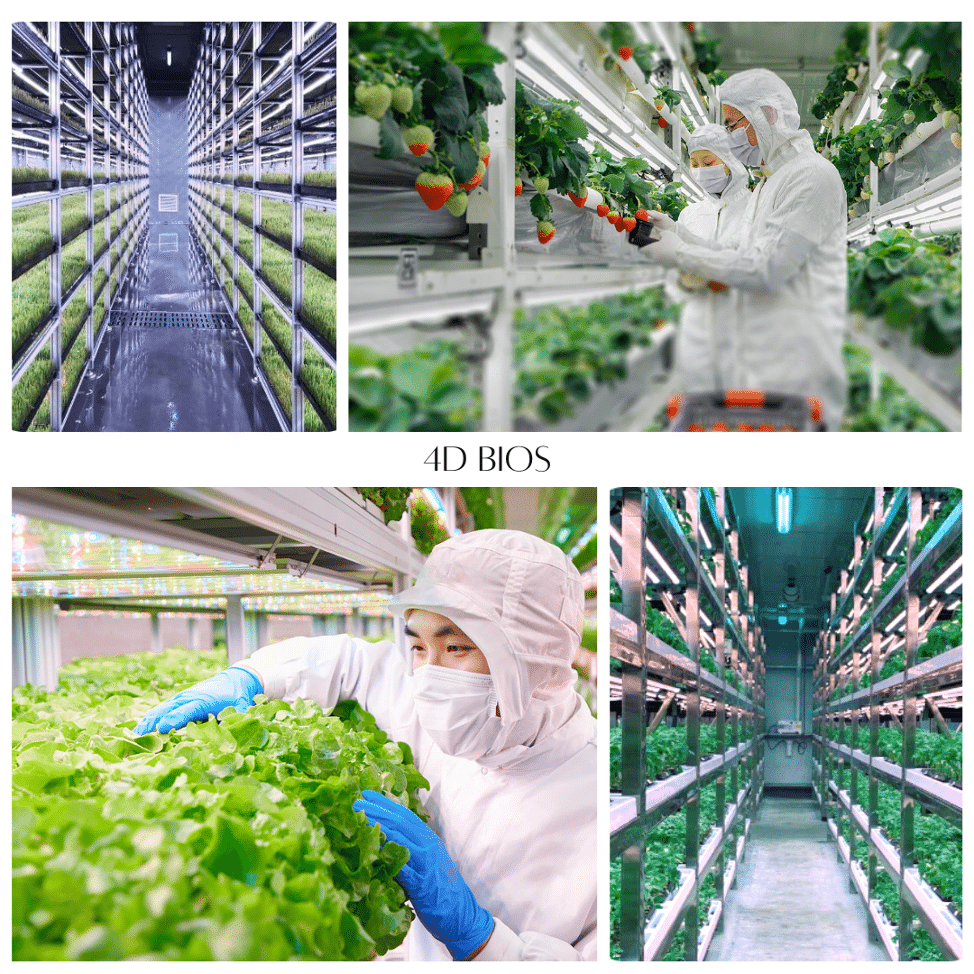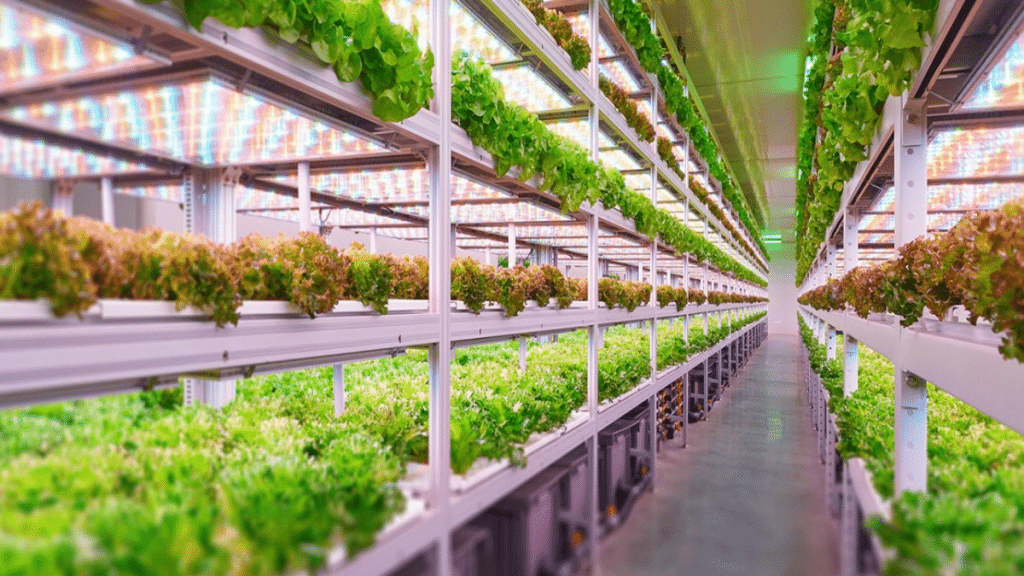Traditional agriculture faces serious challenges today. Unpredictable weather patterns and food safety concerns are two key examples. Labor shortages also affect production. These problems threaten global food security. However, vertical farming emerges as a transformative solution. This innovative approach addresses agriculture’s biggest challenges. It offers hope for sustainable agriculture.
The Three Major Challenges in Traditional Agriculture
Modern agriculture is facing a great deal of scrutiny. With rising demand and limited resource, more traditional practices have not been able to keep pace with each other. Amongst all current issues, three things stand out as highly significant issues:
1. Food Security
As climate change intensifies, the risks to traditional farming continue to grow. The result is an ongoing threat to food stability:
- Vulnerability to Extreme Weather and Natural Disasters: Conventional farming is heavily dependent on stable climatic conditions. However, the rising frequency and intensity of extreme weather events, such as prolonged droughts, catastrophic floods, unseasonal frosts, and powerful storms, can devastate entire harvests.
- Impact on Crop Yields and Supply Stability: When a natural disaster hits a region, the immediate consequence is a sharp decline in crop yields. This not only affects the local food supply but can also have ripple effects worldwide leading to supply chain disruptions, price spikes, and food shortages.
2. Food Safety
Food safety is no longer an abstract issue – it’s a daily concern for millions of people. With traditional farming relying on chemical inputs, harmful residues can end up in the food supply, posing a risk to consumer health. The key concerns include:
- Risks of Chemical Contamination: In an effort to maximize yields, traditional farming has become heavily reliant on chemical inputs. This includes pesticides, herbicides, and synthetic fertilizers to enhance soil fertility. Overuse or improper application can lead to harmful pesticide residues on produce and heavy metal contamination of soil and water sources, which are then absorbed by crops.
- Concerns Over Product Quality: The presence of these residues raises significant public health concerns, with potential links to chronic illnesses. Consumers are becoming increasingly wary of the long-term effects of consuming chemically treated products. These ongoing concerns are pushing demand for chemical-free, secure agricultural methods.
3. Development Security
Agricultural development faces sustainability challenges. Labor costs continue to rise across farming regions, and worker shortages impact harvest timing. Traditional methods consume excessive resources. Here’s an overview:
- Labor Shortages and Rising Costs: Farming is physically demanding work, and many regions are experiencing significant labor shortages as younger generations migrate to urban centers seeking less strenuous employment. This demographic shift, combined with an aging farming population, leads to a smaller workforce. As a result, labor costs are rising, squeezing the profit margins of farmers and making it difficult to operate.
- Low Efficiency and Sustainability Challenges: Compared to modern, technology-integrated methods, traditional farming can be highly inefficient. It often requires more water, more land, and more manual labor to produce the same yield. This not only limits productivity but also raises serious sustainability challenges, such as soil degradation, water depletion, and a high carbon footprint, threatening the ability of the land to support future generations.

Vertical Farming: Transforming the Future of Agriculture
Vertical farming represents the next evolution in agriculture. This method grows crops in vertically stacked layers and uses controlled environments instead of traditional fields. LED lights replace sunlight, and nutrient solutions feed plants directly.
This type of farming addresses the three major security issues effectively. It creates predictable growing conditions year-round and eliminates weather dependency completely. Food safety improves through controlled inputs. Here’s how it addresses the issues:
- Solving Food Security with Controlled Environments: Vertical farms are self-contained ecosystems, completely insulated from external weather conditions. By controlling light, temperature, humidity, and nutrients, they can create the perfect growing conditions for crops 24/7, 365 days a year. This reduces weather-related risks to zero, eliminating the threat of droughts, floods, or pests wiping out a harvest. The result is a highly predictable, stable, and reliable food supply, ensuring consistent yields regardless of the climate outside.
- Ensuring Food Safety with a Clean Ecosystem: Because the growing environment is enclosed and carefully managed, there is no need for pesticides, herbicides, or fungicides. Pests and plant diseases simply cannot get in. This eliminates the risk of chemical residues and heavy metal contamination associated with conventional farming. Produce from vertical farms is clean, safe, and of high quality, offering consumers peace of mind.
- Securing Development with Technology and Efficiency: Vertical farming is a high-tech industry that leverages automation and technology to reduce labor dependency and increase efficiency. Automated systems can handle seeding, watering, nutrient delivery, and even harvesting, drastically reducing the need for manual labor and mitigating the impact of labor shortages and rising costs. Furthermore, these systems are incredibly resource-efficient, often using up to 95% less water and significantly less land than traditional farms. This makes vertical farming a highly sustainable and economically viable model for long-term development.

Plant Factory Technology: Empowering Modern Agriculture
A plant factory is a fully enclosed and insulated facility where all environmental factors required for plant growth—including light, temperature, humidity, carbon dioxide levels, and nutrient delivery—are artificially controlled. Using technologies like LED lighting tailored to specific plant needs and soilless cultivation methods such as hydroponics or aeroponics, plant factories create the ideal conditions for year-round cultivation, completely independent of external weather and geography.
Advantages
Plant factories offer significant benefits over traditional methods. These systems maximize efficiency while minimizing waste, hence producing higher quality crops consistently. Environmental impact drops dramatically compared to conventional farming. The key advantages include:
- Advanced hydroponic setups in plant factories recycle water efficiently, reducing consumption by up to 95%.
- Accelerated crop development enables year-round harvesting with multiple growing cycles.
- Increased yield per unit area produces 50-100 times more crops in the same space.
- No pesticide residues or heavy metal contamination ensures completely clean, safe produce.
Application Scenarios
Plant factories adapt to various crop types easily. Different plants require specific growing conditions. These facilities customize environments for optimal results. Market demand drives specific applications, such as:
- Strawberry Plant Factories: Enables the year-round production of high-demand, high-quality strawberries, ensuring consistent quality and supply regardless of the season.
- Vegetable Plant Factories: Ideal for producing leafy greens like lettuce, water spinach, and kale, as well as herbs, which have short growth cycles and high market demand.
- Medical Herb and Specialty Plant Factories: The ability to precisely control growing conditions is crucial for cultivating high-value medicinal plants (like Ginseng) or specialty crops that require specific environmental triggers to develop their desired traits.
- Fodder Plant Factories: Provides a stable, reliable, and pesticide-free source of fresh animal feed for livestock, improving animal health and reducing reliance on imported feed.

The Future Outlook
Plant factories address agriculture’s most significant challenges. Food security improves through weather-independent production, and food safety increases without chemical inputs. Development security strengthens through automation and efficiency. These technologies represent the future of agriculture. 4D Bios is a leading ag-tech innovator in this space. The company pioneers smart plant factory systems that define farming’s future.
Since its founding in 2018, 4D Bios has focused on advanced technologies like LED lighting, nutrient precision, and full environmental control. With strengths in intelligent automation and crop management, the brand leads in vertical farming innovation worldwide. Its digitalization focus drives agricultural transformation worldwide. Visit the company’s website to discover how its smart plant factory systems can transform your agricultural operations.
